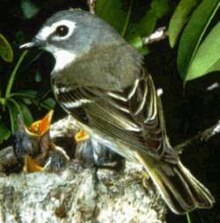Blue-headed vireo
| Blue-headed vireo | |
|---|---|
 |
|
| Scientific classification | |
| Kingdom: | Animalia |
| Phylum: | Chordata |
| Class: | Aves |
| Order: | Passeriformes |
| Family: | Vireonidae |
| Genus: | Vireo |
| Species: | V. solitarius |
| Binomial name | |
|
Vireo solitarius (Wilson, 1810) |
|
The blue-headed vireo (Vireo solitarius) is a Neotropical migrating song bird found in North and Central America. There are currently two recognized sub-species that belong to the blue-headed vireo. It has a range that extends across Canada and the eastern coast of the United-States, Mexico and some of Central America. It prefers large temperate forests with a mix of evergreen trees and deciduous under growth.
As the name suggests, the blue-headed vireo is characterized by its blue-grey head and bold yellow wing bars. Both sexes are very similar in plumage and size. Juveniles also have a similar plumage.
Populations of the blue-headed vireo have been steadily increasing since the 1970s and were therefore classified as a "Least Concern" species in 2004.
The blue-headed vireo has similar plumage year round and does not drastically change its appearance during the breeding season. It can be characterized by its olive green upper body, two bold yellow wing bars down the edge of its wing, and a deep blue-grey crown from which it gets its name. The juvenile plumage of immature blue-headed vireos is not distinct but very similar to the adult plumage. While this bird’s appearance is similar to the closely related Cassin's vireo (Vireo cassinii), the Cassin's vireo can be differentiated by its lighter yellow patches, a smaller, thinner bill, and a brownish-grey crown. There is little to no sexual dimorphism between males and females as both are similar in plumage colouration and size.
Like most Vireos, the blue-headed vireo is a relatively small bird with a length of 126–148 mm (5.0–5.8 in). The wingspan is usually found to be around 200–240 mm (7.9–9.4 in) and their weight is typically 13–19 g (0.46–0.67 oz). There are some subtle differences between the V.s. solitarius and V.s. alticola sub-species. V.s. alticola, the larger of the two sub-species, has a darker back with a larger wing length of 76–83.5 mm (2.99–3.29 in) and a bill length of 11–12 mm (0.43–0.47 in). Conversely, V.s. solitarius is slightly smaller with a wing length of 69.2–77.8 mm (2.72–3.06 in), and a bill length of 8.9–11 mm (0.35–0.43 in).
...
Wikipedia

